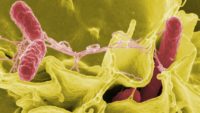Salvus,LLC, a part of the CJB family of companies, recently opened a new facility in Valdosta, Ga. The new facility expands Salvus’ capacity for engineering, research, testing and production. Salvus president and CEO Clinton Beeland explained how this new facility will create opportunities for advancement.
“We’re adding new laboratory space and are beginning our production process, so, a lot of expansion and better capabilities, a lot of room for us to grow,” Beeland said. “We own 15 acres in the business park, and we’ve only consumed about 3 of them, so we have a lot of room to expand beyond the current facilities.”
A news release from Salvus discussed that the new facility holds the manufacturing and packaging space to prepare, assemble and package the technology components to meet commercial demands. Salvus is working on bringing its detection technology to the commercial market.
Meat, poultry and seafood processors can benefit from utilizing the Salvus Detection Technology, the world’s first handheld chemical and biological interferometric detector. Beeland explained that when Salvus was developing the detector, they considered how it could benefit the separate stages of protein production.
“We see it from the beginning to the end, but you have to introduce it somewhere, and so we think that the best place to begin is the one that would have the most value, which is the food processor,” Beeland said. Beeland also highlighted that the detector allows for quicker beginning-to-end connectivity.
Salvus detection technology not only can monitor and detect both chemical and biological substances in liquid, air or surface environments; it also gives results quickly. The ability to deliver results within minutes or seconds instead of hours or days is essential for the safety of animals and humans alike. “There’s a need to speed up testing so you can take action on it, because everything is so much closer together that when something does happen, we can act on it so it doesn’t propagate, much like COVID today, right? It’s the same sort of scenario. Connectivity, and our ability to do both chemical and biological, makes it a unique tool.”
Beeland explained how the detector is a vital tool for meat, poultry and seafood processors as food also is grown closer together. “This increases the chance for pathogens. It increases the controls you need to have, whether it be chemical or environment,” Beeland said. “And so there’s a need for detection and knowing whether what you’ve done is effective, and conversely if there’s a threat that exists.”
Beeland emphasized the importance of the detector for not only poultry, pork and beef processing, but seafood processing, too. “Seafood is also important and, different, of course, different because it’s in a water environment, not in a poultry house,” Beeland said. “Different threats, but the same type of need.”
Standout features of Salvus’ detection technology are its capacity to do multiplexing, its ability to fit on multiple other form factors, and its capability to be fit with one of two types of cartridges for discreet or monitoring situations. Visit here for more about Salvus and its detection technology.





Report Abusive Comment